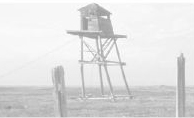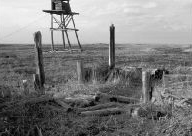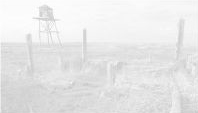Gulag (61 page)

Still, the rebellion was far more than a typical criminal rebellion: it was clearly politically motivated, and openly anti-Soviet. Nor did the participants fit the profile of the typical, criminal runaway: the majority were political prisoners. Rumors of the rebellion would, the NKVD knew, travel quickly around the many nearby camps, which had an unusually high number of politicals during the war years. Some, then and later, suspected that the Germans knew about the Vorkuta camps, and planned to use them as a fifth column, should their march into Russia ever get that far. Rumors that German spies really did parachute into the region persist to this day.
Moscow feared a repeat performance, and took action. On August 20, 1942, all of the bosses of all of the camps in the system received a memorandum: “On the Increase in Counter-Revolutionary Activities in NKVD Corrective-Labor Camps.” It demanded that they eliminate the “counter-revolutionary and anti-Soviet element” in their camps within two weeks. The resulting series of investigations, carried out across the Soviet Union, “uncovered” a massive number of alleged conspiracies, ranging from the “Committee of People’s Liberation” in Vorkuta, to the “Russian Society for Vengeance Against the Bolsheviks” in Omsk. A report published in 1944 declared that 603 insurgency groups operating within the camps had been uncovered in the years 1941 to 1944, with a total of 4,640 participants.
72
Doubtless, the vast majority of these groups were fictitious, created in order to prove that the camps’ internal informer networks were actually doing something. Nevertheless, the authorities were right to be afraid: the Ust-Usa rebellion really would prove to be a harbinger of the future. Although it was defeated, it was not forgotten: neither were the sufferings of the executed socialists and Trotskyites. A decade later, a new generation of prisoners would re-invent the political strike, picking up where the rebels and the hunger strikers had left off, altering their tactics for a new era.
Properly speaking, however, their story belongs to subsequent chapters. They are not part of the history of life in the camps at the height of the Gulag’s reign, but rather part of a later saga: the history of how the Gulag came to an end.
PART THREE
THE RISE AND FALL OF THE CAMP–INDUSTRIAL COMPLEX, 1940—1986
Chapter 19
THE WAR BEGINS

I was a soldier, now I’m a convict
My soul is frozen, my tongue is silent.
What poet, what artist
Will depict my terrible captivity?
And the evil crows didn’t know
What sort of sentence they gave us
When they tortured us, when they chased us
From prison to exile to camp.
But wonders occur! Above the quarry
A free star shines
Although my soul is frozen—it is not shattered
Although my tongue is silent—it will speak!
—Leonid Sitko, 1949
1
COLLECTIVE WESTERN MEMORY generally recognizes September 1, 1939, the date of the German invasion of western Poland, as the beginning of the Second World War. But in the Russian historical consciousness, neither that day, nor September 7, 1939—the date of the Soviet invasion of eastern Poland—count as the start of the battle. Dramatic though it was, this joint invasion, arranged in advance through the negotiations that produced the Hitler-Stalin pact, did not directly affect most Soviet citizens.
By contrast, no Soviet citizen ever forgot June 22, 1941—the day that Hitler launched Operation Barbarossa, his surprise attack on his Soviet allies. Karlo Stajner, then a prisoner in Norilsk, heard the news on the camp radio:
Suddenly the music was interrupted, and we heard Molotov’s voice speaking of the Nazis’ “treacherous attack” on the Soviet Union. After a few words, the program went off the air. There were about a hundred people in the barracks, but you could have heard a pin drop: we were all staring at one another. Vasily’s neighbor said: “It’s all over for us now.”
2
Accustomed to the idea that any major political event was bad for them, political prisoners absorbed the news of the invasion with particular horror. They were right to do so: “enemies of the people”—now seen as a potential fifth column—were in some cases immediately singled out for increased repression. Some—a so-far unknown number—were executed. Stajner records that on the second day of the war, food supplies were cut: “sugar was eliminated, and even our soap ration was cut in half.” On the third day of the war, all foreign prisoners were rounded up. Stajner, an Austrian citizen (although he considered himself a Yugoslav communist), was re-arrested, removed from his camp, and jailed. The camp prosectuors reopened the investigation into his case.
The same pattern repeated itself across the camp system. In Ustvymlag, on the first day of the war, the camp command banned all letters, parcels, and newspapers, and took down the camp’s radio amplifiers.
3
The bosses of Kolyma removed political prisoners’ right to read letters and newspapers, and cut off access to radios too. Everywhere, searches increased, morning counts grew longer.
Lagpunkt
commanders organized special maximum-security barracks for prisoners of German descent. “All you Burgs, Bergs and Steins, fall out on the left. All you Hindenbergs and Ditgensteins and so forth,” the guards called out, indicating that Evgeniya Ginzburg should join them. She managed to dash into the Registration and Distribution office, and persuaded an inspector to look up her nationality and citizenship: “This must have been the first time in the history of the world that being Jewish was an advantage.”
4
The Karlag administration removed all prisoners of Finnish and German origin from the camp lumber factory, and sent them to cut timber. One Finnish American prisoner remembered that “After five days the factory stopped production because the Finns and the Germans were the only specialists who knew how to work . . . Without permission from Moscow, they took us back to the factory.”
5
The most dramatic change, for those affected by it, was the order—also issued on June 22, 1941—forbidding all prisoners convicted of “betrayal of the Motherland, spying, terror, diversion, Trotskyism, rightish tendencies, and banditry” (in other words, all politicals) from leaving the camps. The prisoners called this decree an “extra term,” although it was in fact an administrative order, not a new sentence. According to official records, 17,000 prisoners were immediately affected. Others would be included later.
6
Usually, there was no forewarning: on the day they were due to be released, those who fell under the terms of the order simply received a document instructing them to remain behind barbed wire “for the duration of the war.”
7
Many assumed this meant they would remain in prison forever. “It was only then that I understood the whole tragedy of my situation,” one remembered.
8
The tragedy hit women with children harder than anyone else. One Polish prisoner recounted the story of a woman who had been forced to leave her baby in a nursery outside the camp. Every day of her imprisonment, she thought of nothing but getting her child back. Then, when her release date came up, she was told she would not be set free because of the war: “She threw her work aside and, falling onto the table, she began not to sob but to howl like a wild animal.”
9
Olga Adamova-Sliozberg also tells the story of a woman, Nadya Fyodorovich, due to be released on June 25, 1941. Her son, then living in the home of distant relatives who wished to be rid of him, was waiting for her. She had been writing to him, telling him to be patient. When she learned she was not to be released, she wrote to him again. He did not answer:
At last, in the winter of 1942, she received a letter from a stranger. He had picked Borya up at some remote station in Siberia near Irkutsk, and found that the boy was suffering from pneumonia. He had taken him in and nursed him till he was better. He reproached Nadya for having forgotten about her son as soon as she was released; she was a bad mother; she had probably gone and gotten married and was doing nicely for herself while her fourteen-year-old son, hitching a free ride on a train all the way from Ryazan to Irkutsk, was dying of hunger.
Nadya tried to contact the stranger, but to no avail: the censors were no longer letting political prisoners’ letters through, especially letters which referred to the indefinite extension of prisoners’ sentences. Later, Nadya heard her son had joined a gang. In 1947, he too turned up in Kolyma, with a five-year sentence.
10
For everyone who remained behind barbed wire, life grew harsher as the war progressed. New laws established longer working days. A refusal to work was no longer just illegal; it became an act of treason. In January 1941, Vasily Chernyshev, then the commander of the central Gulag administration, sent a letter to the bosses of all of the camps and colonies, describing the fate of twenty-six prisoners. The camp court system had tried them, found them guilty of refusing to work, and granted five of them an additional ten-year camp sentence. The court sentenced the remaining twenty-one to death. Curtly, Chernyshev told his underlings to “inform the prisoners of all camps and corrective-labor colonies” of these sentences.
11
The message trickled down very quickly. All prisoners, wrote Gustav Herling, knew well that “among the gravest offenses which could be committed in the camp after 22 June 1941 were the spreading of defeatism and refusal to work, which, under the new defense regulations, was included in the category of ‘sabotage of the war effort.’”
12
The results of all of these policies, coupled with the massive food shortages, were dramatic. Although mass executions were not as common as they had been in 1937 and 1938, prisoner mortality rates for 1942 and 1943 are nevertheless the highest in the Gulag’s history. According to the official statistics, which are almost certainly an underestimate, 352,560 prisoners died in 1942, or one in four. One in five, or 267,826, died in 1943.
13
The number of sick prisoners, while officially calculated at 22 percent in 1943 and 18 percent in 1944, was probably much higher than that, as typhus, dysentery, and other epidemics swept through the camps.
14
By January 1943, the situation had become so dramatic that the Soviet government created a special food “fund” to the Gulag: prisoners might be “enemies,” but they were still needed for war production. The food situation did improve as the tide of the war turned in the Soviet Union’s favor, but even with these extra rations, the food norms at the end of the war contained a third less calories than those issued in the late 1930s.
15
In all, well over two million people died in the camps and colonies of the Gulag during the war years, not taking into account those who died in exile and other forms of imprisonment. More than 10,000 of these were shot, for treason or sabotage, on the orders of camp prosecutors.
16
To put these figures and these changes in context, it must also be said that the free population of the Soviet Union also suffered during the war, and that stricter regimes and tighter rules affected workers outside the camps as well as within them. As early as 1940, in the wake of the Soviet invasion of Poland and the Baltic states, the Supreme Soviet established an eight-hour working day and a seven-day working week for all factories and institutions. Even more drastically, the regime forbade all workers from leaving their place of work. To do so became a crime, punishable with a camp sentence. The production of “poor quality” goods (“sabotage”) became a crime too, and sentences for other offenses grew harsher. Workers accused of filching spare parts, tools, paper, or writing instruments from their workplaces could be sentenced to spend a year in a camp—or more.
17
People also starved outside the camps almost as frequently as they starved within them. During the German blockade of Leningrad, bread rations fell to 4 ounces a day, which was not enough to survive on, and heating oil was unavailable, turning the far northern winter into a torment. People caught birds and rats, stole food from dying children, ate corpses, and committed murder to get hold of ration cards. “In their apartments people battled for life, like perishing polar explorers,” remembered one survivor.
18
Nor was Leningrad the only starving city. NKVD reports written in April 1945 describe famine and mass starvation right across central Asia, in Uzbekistan, Mongolia, and the Tartar Republic. Families of frontline soldiers, lacking their breadwinner, suffered the most. Famine hit Ukraine as well: as late as 1947, cases of cannibalism were still being reported.
19
In all, the Soviet Union claimed to have lost twenty million of its citizens during the war. Between 1941 and 1945, the Gulag was not the Soviet Union’s only source of mass graves.
If greater regimentation and stricter rules immediately followed the declaration of war, so did chaos. The German invasion proceeded with shocking speed. In the first four weeks of Barbarossa, nearly all of the 319 Soviet units committed to battle were destroyed.
20
By the autumn, Nazi forces had occupied Kiev, besieged Leningrad, and appeared to be on the verge of capturing Moscow too.
The western outposts of the Gulag were overwhelmed in the very first days of the war. The authorities had closed the remaining barracks on the Solovetsky Islands in 1939, and had transferred all prisoners to mainland prisons: they considered the camp to be too close to the Finnish border.
21
(In the course of the evacuation and the later Finnish occupation, the camp’s archive disappeared. It was probably destroyed, according to standard procedures, but rumors, never substantiated, claim that all of the papers were stolen by the Finnish army and are still hidden in a top-secret government vault in Helsinki.
22
) The authorities also instructed Belbaltlag, the camp which ran the White Sea Canal, to evacuate its prisoners in July 1941, but to leave its horses and cattle behind for the Red Army. There is no record of whether the Red Army managed to make use of them before the Germans got there.
23
Elsewhere, the NKVD simply panicked, and nowhere more so than in the recently occupied territories of eastern Poland and the Baltic states, where the jails were overflowing with political prisoners. The NKVD had no time to evacuate them, yet could hardly leave “anti-Soviet terrorists” in German hands either. On June 22, the very day of the German invasion, the NKVD began to shoot the inmates in the prisons of Lwów, the Polish-Ukrainian city near the German-Soviet front line. While they were carrying out the operation, however, a Ukrainian-led uprising engulfed the city, forcing the NKVD to abandon the prisons altogether. Emboldened by the sudden absence of guards and the sound of nearby artillery fire, a group of inmates in Brygidka prison, in the Lwów city center, smashed their way out. Others refused to leave, fearing the guards might be waiting outside the gates, hoping for just such an excuse to kill them.
Those who remained paid for their mistake. On June 25, the NKVD, reinforced by border guards, returned to Brygidka, freed the “ordinary” criminal prisoners—and machine-gunned the remaining political prisoners in their underground cells. The cars and trucks on the street above drowned out the noise of the shooting. The inmates of the city’s other prisons met a similar fate. Altogether, the NKVD killed about 4,000 prisoners in Lwów, and left them in mass graves which they barely had time to cover with a light layer of sand.
24




